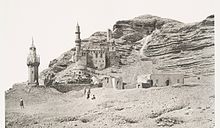geo.wikisort.org - Mountains
The Mokattam (Arabic: المقطم pronounced [almoˈqɑtˤ.tˤɑm], also spelled Muqattam), also known as the Mukattam Mountain or Hills, is the name of a range of hills and a suburb in them, located in southeastern Cairo, Egypt.[1][2]


Etymology
The Arabic name Mokattam means cut off or broken off and apparently refers to how the low range of hills is divided into three sections. Paul Casanova advocated the idea that it's a corruption of an older name Maqaduniya (Arabic: مقدونية), mentioned in Medieval Arabic sources.[3]
Landform
The highest segment is a low mountain landform called Moqattam Mountain.[4] In the past the low mountain range was an important ancient Egyptian quarry site for limestone, used in the construction of temples and pyramids.[1][5]
Settlement

The hills are in the region of ancient Fustat, the new capital founded by 'Amr ibn al-'As after the Muslim conquest of Egypt in 642 CE.[6] The Zabbaleen people, who are an integral part of collecting and processing Cairo's municipal solid waste, live in Manshiyat Naser, Garbage City, at the foot of the Mokattam Hills.[7]

Simon the Tanner
Mokattam is widely known in the Coptic Church, as it is believed that the mountain has moved up and down when the Coptic Pope Abraham of Alexandria, following the advice of Saint Simon the Tanner, performed a mass near it in order to prove to the Caliph that the Gospel is true when it says that "if one has faith like a grain of mustard one can move a mountain". The name "Broken-off Mountain" may be related to the fact that in the story the mountain breaks off from the underlying rock and rises up, before coming back down again.[8]
See also
- Maqaduniya, a region of Medieval Egypt
- City of the Dead, Islamic necropolis and cemetery
- List of types of limestone, ancient Egyptians quarried limestone in the hills
References
- Kamel, Seif. "Al Mokattam Mountain: On top of Cairo". Archived from the original on 2009-01-05. Retrieved 2009-02-05.
- Kebede-Francis, Enku (October 25, 2010). Global Health Disparities: Closing the Gap Through Good Governance. Jones & Bartlett Publishers. p. 320. ISBN 9781449619343.
- Casanova, Paul. "Les noms coptes du Caire et localités voisines". BIFAO. 1: 139–224.
- "Cave Church". Archived from the original on 2007-10-28. Retrieved 2016-11-14.
{{cite web}}: CS1 maint: bot: original URL status unknown (link) - Egerton, Sir Philip de Malpas Grey (1854). "Palichthyologic Notes. No. 8. On some Ichthyolites from the Nummulitic Limestone of the Mokattam Hills, near Cairo". Quarterly Journal of the Geological Society. 10 (1–2): 374–378. doi:10.1144/GSL.JGS.1854.010.01-02.42. S2CID 130754356.
- Rappoport, S. The Founding of Fostât -The Project Gutenberg EBook of History Of Egypt From 330 B.C. To The Present Time, Volume 11 (of 12). Archived from the original on 14 November 2016. Retrieved 14 November 2016.
- Gauch, Sarah (January 6, 2003). "Egypt dumps 'garbage people'". The Christian Science Monitor. Archived from the original on March 22, 2009. Retrieved 2009-02-05.
- BBC Newshour The Angel of Garbage City, October 11, 2014, 20:00 UTC.
External links
На других языках
- [en] Mokattam
[it] Muqattam
Muqattam (in arabo: ﻣﻘﻄﻢ, Muqaṭṭam) è la principale eminenza del Cairo, che si erge a est del Nilo, sulla quale si eleva dal XIX secolo la grandiosa moschea di Mehmet Ali, luogo d'inumazione del primo Wali dell'Egitto, resosi de facto autonomo dal nominale sovrano del Paese, il Sultano ottomano d'Istanbul. Sulle sue falde sorge un'altra moschea dedicata al grande poeta sufi Ibn al-Fāriḍ, ancor oggi meta di pio pellegrinaggio, nel distretto di al-Qadiryia della Qarafa.Другой контент может иметь иную лицензию. Перед использованием материалов сайта WikiSort.org внимательно изучите правила лицензирования конкретных элементов наполнения сайта.
WikiSort.org - проект по пересортировке и дополнению контента Википедии

